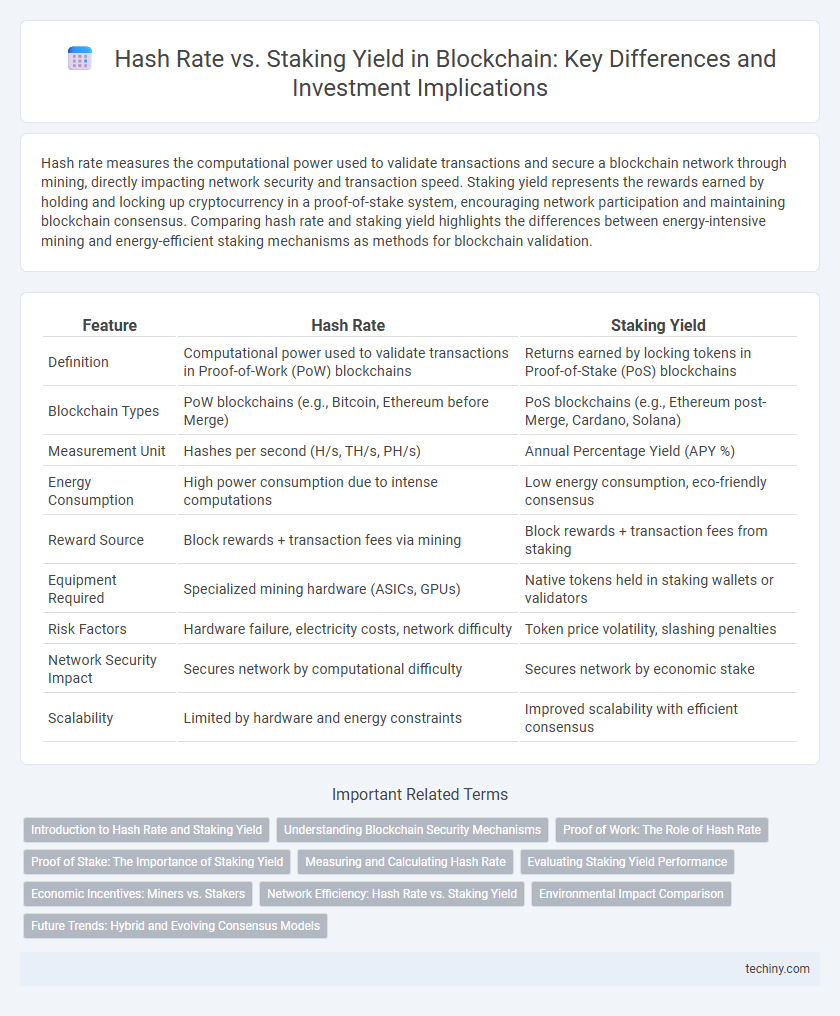Hash rate measures the computational power used to validate transactions and secure a blockchain network through mining, directly impacting network security and transaction speed. Staking yield represents the rewards earned by holding and locking up cryptocurrency in a proof-of-stake system, encouraging network participation and maintaining blockchain consensus. Comparing hash rate and staking yield highlights the differences between energy-intensive mining and energy-efficient staking mechanisms as methods for blockchain validation.
Table of Comparison
| Feature | Hash Rate | Staking Yield |
|---|---|---|
| Definition | Computational power used to validate transactions in Proof-of-Work (PoW) blockchains | Returns earned by locking tokens in Proof-of-Stake (PoS) blockchains |
| Blockchain Types | PoW blockchains (e.g., Bitcoin, Ethereum before Merge) | PoS blockchains (e.g., Ethereum post-Merge, Cardano, Solana) |
| Measurement Unit | Hashes per second (H/s, TH/s, PH/s) | Annual Percentage Yield (APY %) |
| Energy Consumption | High power consumption due to intense computations | Low energy consumption, eco-friendly consensus |
| Reward Source | Block rewards + transaction fees via mining | Block rewards + transaction fees from staking |
| Equipment Required | Specialized mining hardware (ASICs, GPUs) | Native tokens held in staking wallets or validators |
| Risk Factors | Hardware failure, electricity costs, network difficulty | Token price volatility, slashing penalties |
| Network Security Impact | Secures network by computational difficulty | Secures network by economic stake |
| Scalability | Limited by hardware and energy constraints | Improved scalability with efficient consensus |
Introduction to Hash Rate and Staking Yield
Hash rate measures the computational power used to secure and validate transactions on a blockchain, directly impacting network security and transaction speed. Staking yield refers to the rewards earned by participants who lock their cryptocurrency in a proof-of-stake (PoS) network, incentivizing network participation and governance. Both metrics play crucial roles in blockchain ecosystems by balancing security and economic incentives.
Understanding Blockchain Security Mechanisms
Hash rate and staking yield represent two fundamental mechanisms securing blockchain networks, with hash rate reflecting the computational power dedicated to mining in Proof of Work (PoW) systems and staking yield quantifying rewards for locking assets in Proof of Stake (PoS) protocols. Higher hash rates enhance network security by increasing the difficulty of attacks, while elevated staking yields incentivize token holders to participate in consensus and maintain network integrity. Evaluating these metrics helps assess the robustness and economic incentives underpinning different blockchain security models.
Proof of Work: The Role of Hash Rate
Hash rate represents the total computational power used by miners to solve cryptographic puzzles in Proof of Work (PoW) blockchains, directly impacting network security and transaction validation speed. Higher hash rate increases resistance to attacks like 51% attacks, ensuring data integrity and consensus reliability. Unlike staking yield in Proof of Stake (PoS) systems, PoW rewards miners proportionally to their hash rate contribution rather than token holdings, driving competition and energy consumption.
Proof of Stake: The Importance of Staking Yield
Staking yield in Proof of Stake (PoS) blockchains directly influences network security by incentivizing participants to lock tokens, increasing overall network stability and reducing the risk of attacks. Unlike hash rate in Proof of Work (PoW) systems, staking yield rewards validators proportionally to their stake, promoting energy efficiency and decentralization. Higher staking yields attract more validators, enhancing consensus reliability and supporting long-term blockchain scalability.
Measuring and Calculating Hash Rate
Hash rate measures the computational power used to mine and process transactions on a blockchain, typically calculated in hashes per second (H/s). Accurate measurement involves tracking the total number of hashes generated by miners over a specific time frame to assess network security and mining efficiency. Unlike staking yield, which reflects passive income from holding tokens, hash rate directly indicates the active computational effort securing the network.
Evaluating Staking Yield Performance
Evaluating staking yield performance requires analyzing the annual percentage rate (APR) in relation to the network's hash rate stability and overall blockchain security. Higher staking yields can indicate increased participation but may also signify inflationary pressures or reduced network resilience compared to environments dominated by high hash rates. Effective performance assessment balances staking rewards with factors such as validator uptime, consensus algorithm efficiency, and tokenomics to ensure sustainable blockchain growth.
Economic Incentives: Miners vs. Stakers
Hash rate directly correlates with the computational power miners invest to validate transactions, earning block rewards and transaction fees as primary economic incentives. In contrast, staking yield represents rewards distributed to validators who lock their cryptocurrency, incentivizing network security and consensus participation through fixed or variable returns. Miners face high operational costs and hardware expenses, while stakers benefit from lower energy consumption and more predictable income streams, shaping distinct economic motivations in blockchain ecosystems.
Network Efficiency: Hash Rate vs. Staking Yield
Hash rate measures the total computational power securing a Proof of Work blockchain, directly impacting network security and transaction validation speed. Staking yield, common in Proof of Stake systems, reflects the rewards earned for locking tokens, incentivizing participation and maintaining network consensus. Network efficiency improves when staking yields align with optimal hash rates, balancing energy consumption and security for sustainable blockchain performance.
Environmental Impact Comparison
Hash rate in blockchain mining requires substantial electricity consumption, resulting in a significant carbon footprint due to energy-intensive Proof of Work (PoW) mechanisms. Staking yield, based on Proof of Stake (PoS), consumes far less energy, enabling networks to operate with minimal environmental impact and lower carbon emissions. This stark contrast highlights staking as a more sustainable blockchain consensus method compared to the energy-heavy mining process tied to hash rates.
Future Trends: Hybrid and Evolving Consensus Models
Hybrid and evolving consensus models are shaping the future of blockchain by integrating hash rate-intensive proof-of-work with energy-efficient staking yield mechanisms. These models aim to balance security, decentralization, and sustainability by dynamically adjusting consensus protocols based on network conditions and economic incentives. As adoption grows, innovations like proof-of-stake combined with proof-of-work hybrids are expected to enhance scalability while maintaining robust network integrity.
Hash Rate vs Staking Yield Infographic

 techiny.com
techiny.com